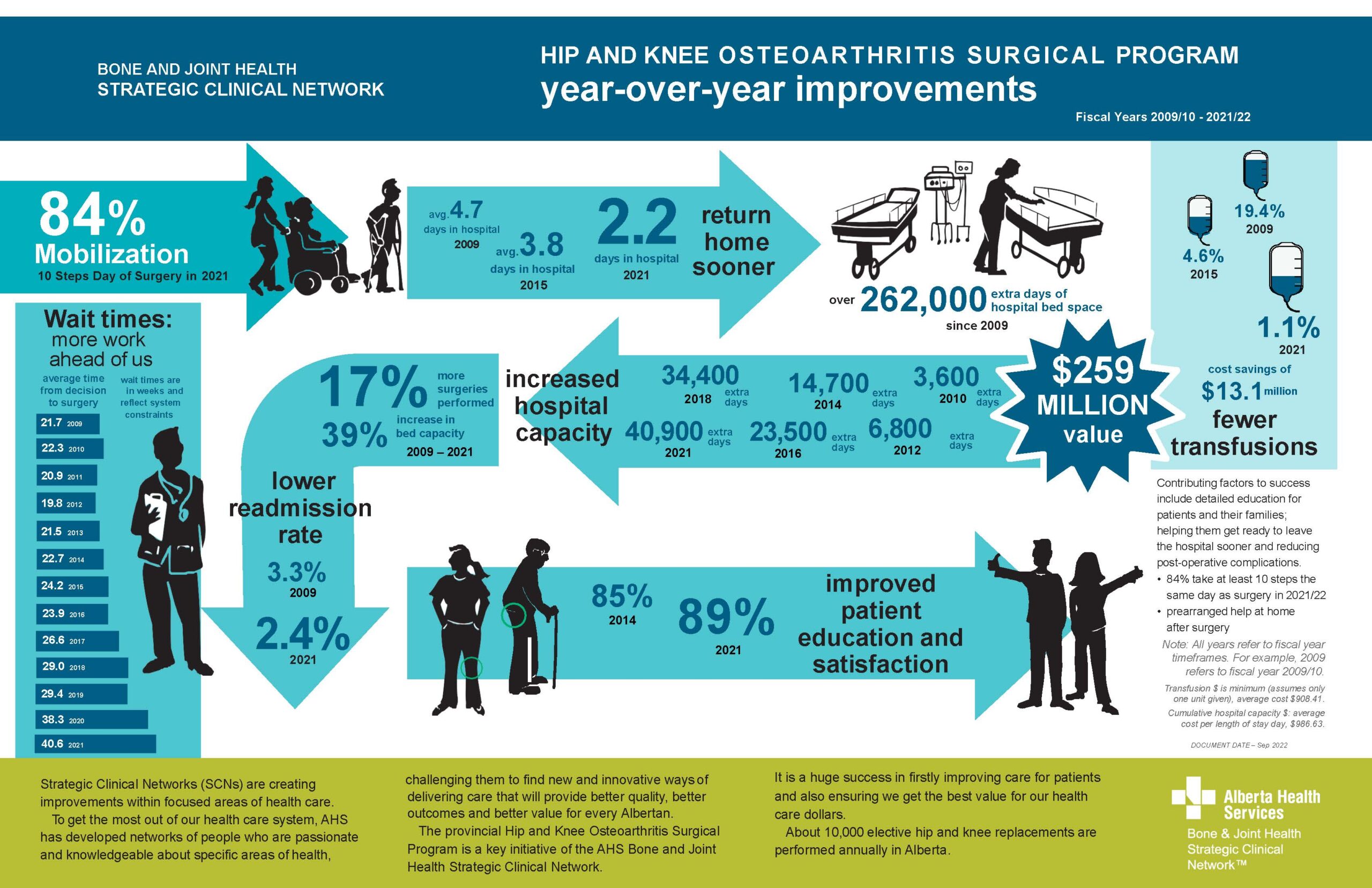MEASUREMENT
Why is Measurement Used in the Program?
The Hip and Knee Osteoarthritis Surgical Program began in 2004 with the Alberta Hip and Knee Replacement project, which conducted a randomized control trial testing a new model of care against the standard of care in Calgary, Edmonton, and Red Deer. This new model included the design and implementation of an integrated Hip and Knee Surgical Care Path and Measurement Framework to standardize best practices and evaluate performance. The framework includes key performance indicators (KPIs) in each of the Health Quality Council of Alberta’s six dimensions of health care quality: safety, accessibility, acceptability, effectiveness, efficiency, and appropriateness.
The success of this project sparked a provincial initiative, aided by the foundation of Alberta Health Services in 2009, to spread and scale this new model of care across the province. As a result, a clinical committee of orthopedic surgeons was established to annually review and evaluate new evidence pertaining to the Hip and Knee Surgical Care Path and Measurement Framework. The proven success of the Measurement Framework inspired the development of similar evidence-based measurement frameworks for the Hip Fracture and Inflammatory Arthritis Programs. The evaluation of the long-term trends in each KPI measure provide feedback to clinicians and hospital teams to enable site level quality improvement initiatives and create a consistency of practice.
Hip & Knee Measurement Framework
The Hip & Knee Measurement Framework includes KPIs in each six dimensions of health care quality (safety, accessibility, acceptability, effectiveness, efficiency and appropriateness). Each key performance indicator is associated with an evidence-based target benchmark and is used to track the Hip & Knee Surgical Care Path’s performance and guidance provided to patients. These results will be tracked and measured against the target benchmarks, to gauge whether the care path is generating the intended high quality of care to all hip and knee arthroplasty patients.
Hip and Knee Measurement Framework
Read more about using measurement for change and local QI projects.
Measurement Tools
Balanced Scorecards
In 2010, under the sponsorship of the BJH SCN, ABJHI began its efforts to reduce the wait times for hip and knee replacements in the province, while providing an innovative model of care for everyday practice. To work towards achieving this ambitious goal, ABJHI developed a highly effective and essential tool known as the Balanced Scorecard. The Balanced Scorecard enables each site team to set and track a mix of performance measures against targets leading to a strategic objective. It supports the practical implementation of the best practices and protocols outlined in the integrated H&K Surgical Care Path.
Each site team involved in the provision of care would establish the mandatory performance measures set by the provincial working group and their site-specific performance measures. Efficiency and accessibility measures, such as “In-hospital length of stay” and “Wait times for surgery”, were mandatory indicators to be included in the balanced scorecards. Once the targets were selected, each site team would set their baseline in each measure, weigh each target according to its importance and track their progress along the way. These balanced scorecards allow teams to establish common goals and a strategy for achieving them. As site teams review the scorecards on a quarterly basis with their local teams, it also serves as a means of communication and an opportunity for collaboration with site counterparts. This creates an undercurrent of competition as teams strive to achieve objectives.
Balanced scorecard methodology continues today and is provided to each site on a quarterly basis (based on AHS fiscal quarter). Many of the KPIs come from administrative datasets that ABJHI have access to. Some site-specific measures are not integrated into the clinical record and must be provided to ABJHI “manually” as aggregated quarterly data. Each site has their own method for how they track and collect the data.
Want to change a measure on your scorecard?
KPI Reports
The Key Performance Indicator (KPI) report was introduced to the H&K OA Surgical Program in 2019 and is paired with the quarterly balanced scorecard. The KPI report shifts the focus provincially, illustrating trends for aggregate site-level, zone-level, and provincial-level performance over the previous 4 reporting periods (based on AHS fiscal quarters).
Trigger Summary and ULI Reports
The Trigger Summary report was introduced to the program in 2019 and is paired with the quarterly balanced scorecard and KPI Report. Using statistical analysis, the trigger summary reports highlight when a site is above or below the expected for an indicator. Positive triggers are meant to be celebrated with your team, whereas negative triggers indicate areas for attention. For any negative triggers, a Unique Lifetime Identifier (ULI) report is sent to site representatives enabling sites to investigate and conduct a deep dive in their site clinical record using the ULI patient list.
CI Reports
Twice per year, ABJHI delivers continuous improvement (CI) reports on unilateral primary elective hip and knee replacement to surgeons, site, and zone leaders engaged in hip and knee replacement care across the province. Each report measures results for KPIs from the measurement framework and is risk adjusted to control for variations in age, sex, procedure, and pre-surgical risk factors (e.g. history of cardiac condition, hypertension, circulatory disorders). The CI report timeframes are based on 1-year of data.
Physicians receivied individualized CI reports which are completely confidential; surgeons see their results compared to the aggregate results of their peers across the zone, the aggregate provincial results, and provincially endorsed benchmarks (where available). The zone CI reports are not confidential and measure aggregate site-level, zone-level, and provincial-level performance compared to the provincially endorsed benchmarks. Alike the quarterly reports, CI Reports are used by individuals and teams to inform on local quality improvement efforts and identify future opportunities for improvement.
